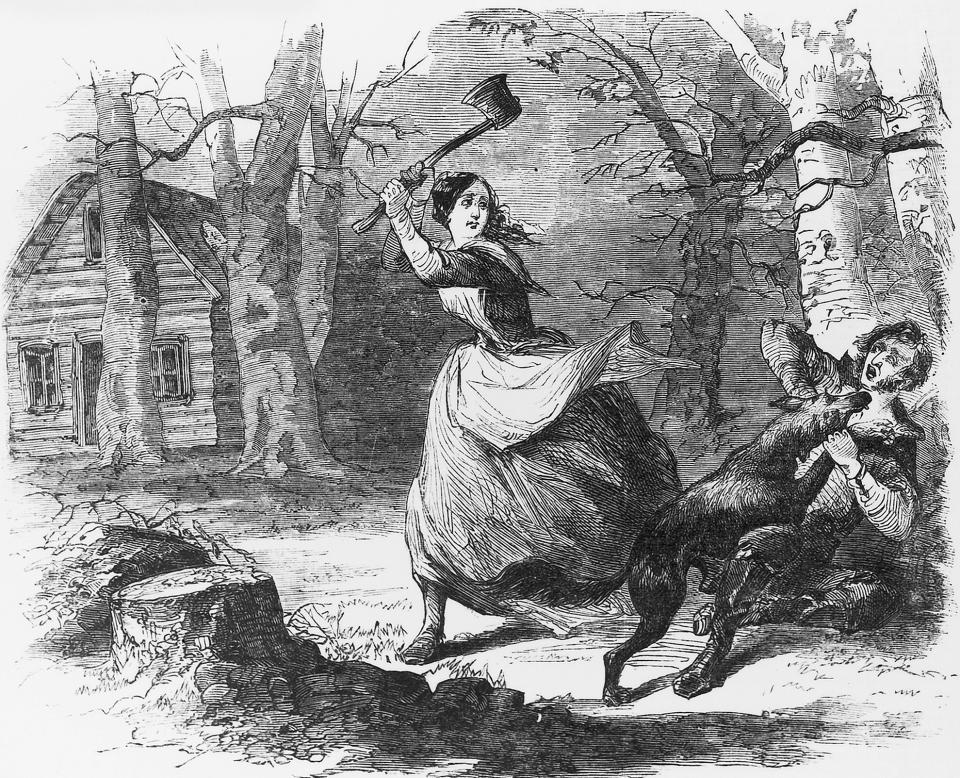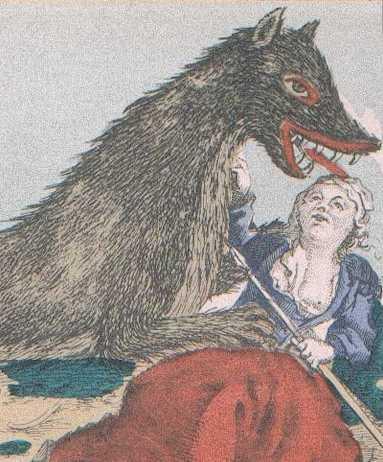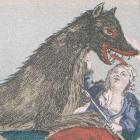It was a mid-September morning in 1897 when Otto Gewehrson approached the town offices in Grand Rapids. The Minnesotan farmer carried three hides in astonishing condition: the tattered remains of three wolves, a New York Times article described a fortnight later, had borne “incontestable” witness to the bounty Otto now came to collect. Through a thick German accent, he claimed: “I killed ’em.” The clerk doubtless raised an eyebrow. All three looked “as if they had been through a contest with a buzz saw.” A frontier farmer would not kill a wolf in this fashion. “I killed ’em,” Otto insisted: “Not mit mine gun . . . mine woman killed ’em mit ein axe.”

An unnamed “frontier housewife” appears on the cover of Frank Leslie’s Boys’ and Girls’ Weekly: An Illustrated Journal of Amusement, Adventure, and Instruction in March of 1867.
An unnamed “frontier housewife” appears on the cover of Frank Leslie’s Boys’ and Girls’ Weekly: An Illustrated Journal of Amusement, Adventure, and Instruction in March of 1867.
This image has been cropped. Courtesy of the Library of Congress. Click here to view source.
 This work is licensed under a Creative Commons Public Domain Mark 1.0 License.
This work is licensed under a Creative Commons Public Domain Mark 1.0 License.
Otto was away when his young shepherd son was attacked. When she heard the screams, yips, and panicked bleats, Mrs. Gewehrson started to run. Snatching her husband’s axe, she arrived at the tree to which the boy clung and “without a moment’s pause,” the article boasted, she began to swing. Three wolves soon lay dead, and her child was restored to her, unharmed. “Slaughtered Three Wolves,” the headline trumpeted, concluding that “no one would ever doubt the prowess of [America’s] frontier housewives.”
Mrs. Gewehrson’s story is a familiar one. Gendered reimaginings of European wolf tales appear in US print media throughout the nineteenth century—often, with an absent male figure’s abandoned axe taken up in domestic defense against similar “desperate odds.” In Vicious: Wolves and Men in America (2004), Jon T. Coleman includes a reference to another example, published three decades prior to Mrs. Gewehrson’s story. Indeed, the cover of an early March 1867 issue of Frank Leslie’s Boys’ and Girls’ Weekly provides a further exemplification: a husband attacked, another “frontier housewife” rushing to the rescue, another wolf hacked to bloody bits by a feminine heroic figure (this time, she is too late). If the American frontier was, as Coleman describes in Here Lies Hugh Glass (2012), a “swindle as well as a stage for masculine regeneration,” it also offered opportunities for feminine regeneration.

A North American wolf hunter, or “wolfer,” shown here on horseback with a team of hunting dogs in North Dakota, c. 1904.
A North American wolf hunter, or “wolfer,” shown here on horseback with a team of hunting dogs in North Dakota, c. 1904.
Click here to view source.
 This work is licensed under a Creative Commons Public Domain Mark 1.0 License.
This work is licensed under a Creative Commons Public Domain Mark 1.0 License.
Frontier disrupted European gender norms and their accompanying, folkloric binaries. As Schach’s 1983 “Russian Wolves in Folktales and Literature of the Plains” argues, wolf stories could also be characterized by a binary, falling “into two distinct groups,” with either humorous or tragic endings. Germanic wolf tales have been well examined for their basis in the popular mythologies of the older, European worlds, where they—and the settlers who told them—originated. When US national ideas about frontier converged with European wolf lore’s gendered archetypes, new stories evolved to suit frontier conditions. Bloody interactions with predators, incursions into Indigenous land, and the unfamiliar climate and geography of western North America dealt more-than-human scars to early nineteenth-century settlers. Coleman’s 2012 work describes men reshaped by the West: the frontier created “new male bodies,” divorced from settlers’ ties to European ideals of gender. As more European feminine figures went westward with the latter half of the century, so did the villains and heroes of their stories, giving environmental historians good reason to revisit Mrs. Gewehrson’s tale.
Settler notions of villainous nature are born of just such bloody, gendered scenes. As Coleman’s Vicious and Rutherford’s Villain, Vermin, Icon, Kin substantiate, wolves were a national enemy. Those who killed canids were eliminating both physical and ideological threats to colonization—incarnating, in Coleman’s words, the “anxieties” thereof, sometimes achieving national “lioniz[ation]” as heroes. As the United States waged war westward, the killers of lupine villains policed the boundaries between human and predator.

An eighteenth-century print shows Marie Jeanne Vallet engaged in bloody confrontation with the Beast of Gévaudan. She is shown attempting to defend herself and her livestock from the canid in the Mercoire forest. c. 1764–67.
An eighteenth-century print shows Marie Jeanne Vallet engaged in bloody confrontation with the Beast of Gévaudan. She is shown attempting to defend herself and her livestock from the canid in the Mercoire forest. c. 1764–67.
Accessed via Wikimedia Commons. Click here to view source.
 This work is licensed under a Creative Commons Public Domain Mark 1.0 License.
This work is licensed under a Creative Commons Public Domain Mark 1.0 License.
Men at war, ideological or otherwise, leave many axes on the ground back home—and print media proved an ideal vector for a gendered regeneration of Germanic wolf tales that paired well with the national agenda. As Hauck et al. conclude in Tracing the Heroic Through Gender, heroines “undergoing quest myths” often surface in times of war: stories of femininized civilian hardship circulate in parallel to masculine “accounts of the battlefront.” But, as Fraser et al. establish in Gender and the Victorian Periodical, print, a “liminal space and negotiating ground” for gender, was not always so binary.
Where shows of bloody, brute force like Mrs. Gewehrson displayed may otherwise have drawn gendered criticism within the nineteenth century’s masculine-controlled print market, wolf-killing frontierswomen were valorized for their subversion of contemporary gender roles. “Had she been a man,” the New York Times crooned in 1897, the wolves would have killed her—but “being a woman facing the most desperate odds in defense of her child,” the publication conceded, made her “more than a match.” Whereas under different circumstances, a woman participating in masculinized folk-hero roles might have earned the criticism of a nineteenth-century readership for what Fraser et al. termed “mannish” behavior, the Gewehrson tale’s subversion of established binaries was the mechanism by which wolf-killing men were, as Coleman put it in Vicious, “lionized.” The celebration of Mrs. Gewehrson’s masculinity on a national stage thus reflects a conditionality to settler lupine lore.
In violent defense of a heterosexualized, national role, print provided a vector by which feminine disruptors of established gender roles could be codified and contained, and perhaps, re-hewn. Mrs. Gewehrson’s axe is similarly double-edged: if wolves were enemies of the state, gendered regenerations of wolf lore in print must be considered ideological weapons of state. While the history of Wolves and Men in America has been written, we must further press Mrs. Gewehrson: for whom does your axe truly swing?
PRIMARY SOURCES
- “Slaughtered Three Wolves,” New York Times, 26 September 1897.
How to cite
Abbott, Caroline. “Axes on the Ground: Wolves and Women in Euro-America.” Environment & Society Portal, Arcadia (Autumn 2023), no. 19. Rachel Carson Center for Environment and Society. doi:10.5282/rcc/9688.
ISSN 2199-3408
Environment & Society Portal, Arcadia
 This work is licensed under a Creative Commons Attribution 4.0 International License.
This work is licensed under a Creative Commons Attribution 4.0 International License.
2023 Caroline Abbott
This refers only to the text and does not include any image rights.
Please click on an image to view its individual rights status.
- Coleman, Jon T. Here Lies Hugh Glass: A Mountain Man, a Bear, and the Rise of the American Nation. New York: Farrar, Straus and Giroux, 2012.
- Coleman, Jon T. Vicious: Wolves and Men in America. New Haven: Yale University Press, 2004.
- Fraser, Hilary, Judith Johnston, and Stephanie Green. Gender and the Victorian Periodical. Cambridge: Cambridge University Press, 2003.
- Hauck, Carolin, Monika Mommertz, Andreas Schlüter, and Thomas Seedorf, eds. Tracing the Heroic Through Gender. Helden, Heroisierung, Heroism, edited by Ronald G. Asch, Barbara Korte, and Ralf von den Hoff. Baden-Baden: Ergon Verlag, 2018.
- Rutherford, Stephanie. Villain, Vermin, Icon, Kin: Wolves and the Making of Canada. Montreal: McGill-Queen’s University Press, 2022.
- Schach, Paul. “Russian Wolves in Folktales and Literature of the Plains: A Question of Origins.” Great Plains Quarterly 3, no. 2 (1983).








